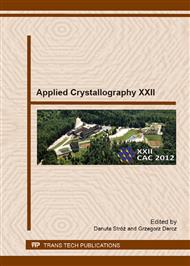p.306
p.310
p.315
p.319
p.323
p.327
p.331
p.335
p.339
Microstructure and Electrical Properties of Nano- and Micro-Sized Powders of Y2O3 Type
Abstract:
Results of morphology and electrical properties evaluation of Y2O3 powders were presented in this article. The tests were made on the two different types of powders. First of them was a powder of the "microsize" type with the particle sizes not crossing10 µm, however the size of particles of the second powder was located in range 30 - 50 nm. Totally different was a morphology of both powders as well. In the first case the form of dense polyhedrons about the smooth surface was observed. However the powder of the type nano was characterized by spongy conglomeration of nano particles type of morphology. The range of investigations included the evaluation of the phase composition of powders (X-ray and electrons diffraction), characteristics of their morphology (SEM, STEM) and evaluation of electric properties by impedance spectroscopy. The obtained results showed that nano powders of oxide Y2O3 is different in the morphology of individual particles, but he is also better ionic conductor in the temperature of 20°C comparing to powder the micro type.
Info:
Periodical:
Pages:
323-326
Citation:
Online since:
June 2013
Keywords:
Price:
Сopyright:
© 2013 Trans Tech Publications Ltd. All Rights Reserved
Share:
Citation:


